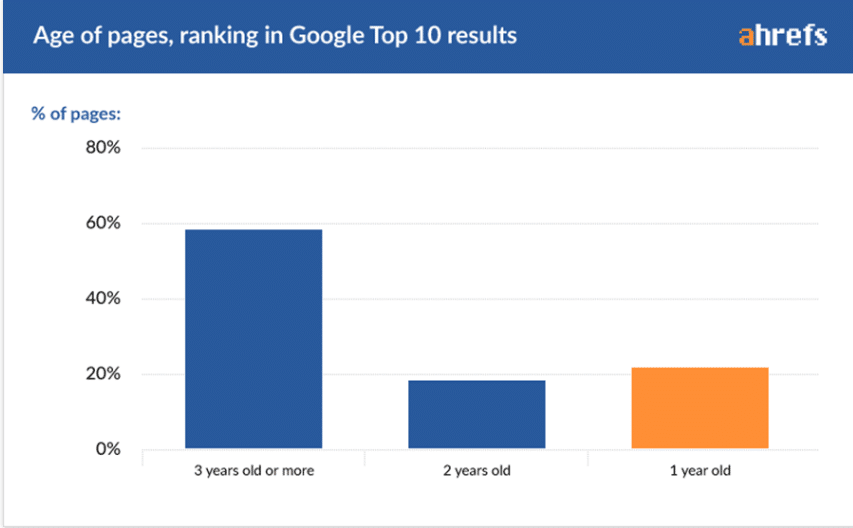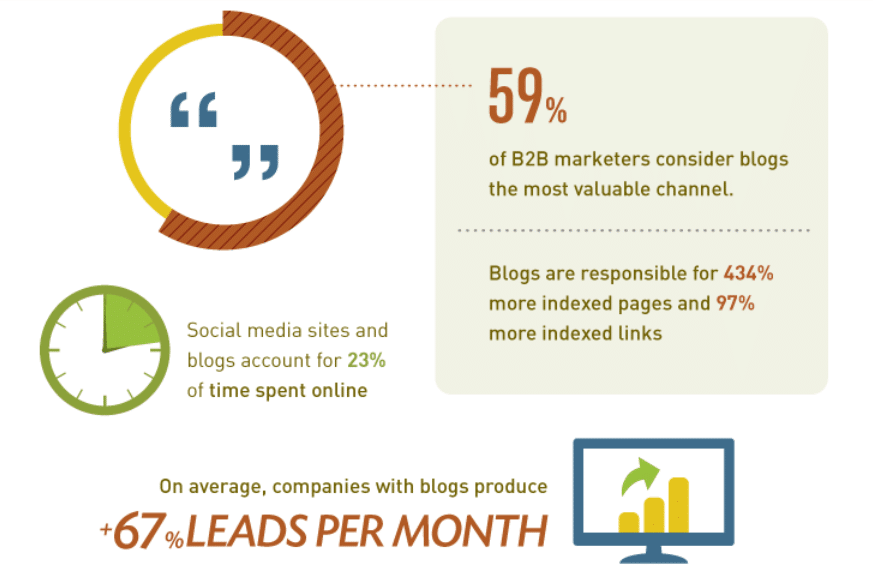Search engine optimization (SEO) is critical for all SaaS companies whether they’re working on driving traffic, generating leads, or increasing revenue. However, tracking the right SEO analytics and metrics can be tricky, especially for new companies.
According to a survey report by Harvey Nash Group, SaaS is considered one of the most important technologies in business success. Since most SaaS companies depend heavily on organic traffic, devising a great SEO strategy is critical. A study by Ahrefs revealed that the average top 10 ranking pages on Google are more than two years old and the top one is over three years old. By understanding and tracking the right SEO analytics and metrics, SaaS companies can improve their online visibility, generate more leads, and drive business growth.

In this guide, we will discuss what SaaS analytics and metrics are, the steps to select the right metrics, the top five metrics to track for SaaS companies, and SaaS SEO and analytics tools.
What are SaaS Analytics?
The term SaaS analytics refers to the process of collecting, measuring, and analyzing the SEO performance data of a SaaS business. The data encompasses various key performance indicators (KPIs) relevant to SEO including keyword ranking, website traffic, and conversion rates. Analyzing this data helps SaaS gain insights into their SEO efforts and identify areas of improvement in their SEO strategy.
What is a KPI and Why it Matters for SaaS SEO?
In SaaS SEO, KPI refers to a measurable value or benchmark that SaaS businesses use to track performance and growth. They provide insights into how well the website is performing, identify areas of improvement, evaluate SEO efforts, and help businesses make data-driven decisions.
In short, SaaS KPIs (if used well) can tell you what’s working and what isn’t and enable you to act quickly on issues and prevent losses.
A few common SaaS SEO KPIs are website traffic, click-through rate (CTR), conversion rate, bounce rate, keyword ranking, etc. By tracking these KPIs, businesses can identify trends, measure progress, and improve their SEO strategy.
How to Choose the Right Metrics for Your SaaS Business?
Every SaaS business owner hears the word KPI (key performance indicator). It’s really just a fancy way of saying “the most important metrics to track your business’ progress”.
You may think that you need to track every metric that seems important, but it’s really quite the opposite. There’s too much going on, and tracking too many metrics can distract you from the important trends and make it impossible to act in time. It’s best to handpick the key metrics that you need to measure your business success. Most professionals recommend tracking less than 10 key metrics. Not only does it make things easier, but also much clearer.
To choose the right metrics to track for your SaaS business, you need to consider if they help you see your business performance and make data-driven decisions.
6 Steps to Choose the Right Metrics for Your SaaS Business
Step 1: Define Your Business Goals
The first step in choosing the right metric for your business is defining your business goals and objectives. This helps you find metrics that closely relate to your SEO strategy. To define your business goal, ask yourself questions like:
- What am I trying to achieve with my SaaS product?
- What is my goal? Is it to increase revenue, improve user engagement, acquire more customers, or expand to new regions?
Step 2: Recognize Your Growth Stage
Every Business, big or small, goes through multiple growth stages. Each stage has unique goals that influence the metrics that you’re tracking at a given time. For example, a newly-launched business is likely focused on customer acquisition while an established business will focus more on customer retention.
It’s worth mentioning that the right metrics at each stage may be different, which means that it’s not a done deal. For example, organic traffic and backlinks are excellent KPIs during the early stage while you’re focused on brand awareness. On the other hand, keyword ranking and CTR are important during the growth stage when you’re more focused on acquiring more traffic.
You need to repeat the process from time to time in order to make sure that you’re still collecting relevant and actionable data.
Step 3: Identify Target Audience
In business, customers are everything, which is why identifying your target audience is a crucial part of choosing the right metrics. You also need to determine their needs, preferences, and pain points and relate to them. Identifying your target audience helps you choose metrics that best reflect their interests and behaviors.
Step 4: Determine Your KPIs
Key performance indicators (KPIs) help you measure the progress you’ve made toward your business goals. Select KPIs that align with your business goals and SEO strategy. For example, if your goal is to increase revenue, then your KPIs may be conversion rates and customer lifetime value (CLV) and if the focus of your SEO strategy is content marketing, then organic traffic and keyword rankings may be relevant.
Step 5: Establish Benchmarks for Your SaaS Metrics
At the very beginning (and even after some time), setting reasonable benchmarks can be challenging and there’s no point in setting arbitrary numbers. For starters, you can search industry benchmarks in your area to get an idea. However, if you’ve been operating for some time, then you can measure your own numbers and compare them to old numbers to see the growth in real time.
Step 6: Leverage Data to Make Informed Decisions
Choosing the right metrics is just one step toward success. You need to collect and leverage the data to make informed decisions and optimize your SEO strategy. Over time, monitor the metrics closely to analyze trends and make data-driven decisions to improve the visibility, reach, and engagement of your SaaS product.
Key Metrics to Track for SaaS SEO
Revenue Metrics
In the SaaS business, all investments are upfront. You spend loads of money building a product before acquiring a single customer. SaaS businesses make money through subscriptions and that needs to be sustainable.
In a SaaS business, we track monthly recurring revenue (MRR) instead of monthly revenue. It’s the amount of revenue that a SaaS business gets from its subscriptions on a monthly basis. Here, the important question is not how much revenue you’re generating but will the revenue be there next month.
What makes MRR an important metric is that it reflects the health and growth of a SaaS business. Compared to one-time purchases or sporadic sales, MRR is stable, hence a better indicator of a SaaS business’s long-term success. It can help SaaS businesses measure growth, predict future revenue, and make data-driven decisions to improve their business strategy. It can also be used to calculate other important metrics like churn rate and customer lifetime value (CLV).
Conversion Metrics
Conversion is a pretty versatile statement. For a SaaS business, conversion may be an action taken by someone that’s essential for the success of your SaaS product. For example, demo requests, product subscriptions, free trial sign up, and contact from submission are all considered conversions.
Tracking conversions tell a SaaS business how profitable its organic traffic has been. Contrary to revenue, an increase in organic traffic can be attributed to your SEO strategy. So, before focusing on SEO, it’s essential to understand your current organic traffic and take a six-month average to set a benchmark.
Churn Metrics
Big businesses focus more on customer retention than acquisition. However, retaining customers is important for all businesses, big and small as it determines whether you survive in the business world. So, it’s important to ask how many of your customers are coming back.
Churn measures the percentage of people who stop using a product or service over a certain period of time. In SaaS, it refers to customers who cancel or do not renew their subscription at the end of the subscription period.
A high churn rate (generally double digits) indicates that something is definitely wrong with your SaaS product and low churn leads to higher revenue. So, before working on marketing or growth, find and fix the problem causing the high churn rate.
The best way to figure out the problem is to get in touch with customers. Ask those who left why they did it, get in touch with your long-term customers, and ask them what’s keeping them, get in touch with potential customers and ask what they need the most. In short, get in your customer’s shoes and make the best product for them.
Organic Traffic Metrics
Organic traffic is visitors that come to your website from unpaid sources, specifically search engines. It’s top-of-the-funnel traffic that generally converts more than traffic from other sources like paid search, display advertising, and paid social. A study by BrightEdge found that 53% of the overall website traffic comes from organic searches.
What makes organic search powerful is that the searcher is actively looking for something. They’re either ready or getting ready to buy what the business is selling and need little convincing. They often convert to paid customers once persuaded and reflected in the monthly recurring revenue.
However, generating revenue from organic search requires long-term SEO strategies and monitoring analytics. The organic traffic on each content piece helps identify what you’re doing right or wrong. According to HubSpot, companies that have a blog receive 97% more links to their site than companies that don’t. A simple distinction that can make a world of difference.

Keyword SERP Ranking
When it comes to measuring the importance of your SEO strategy, your SERP rankings are an important factor. While revenue is the ultimate goal, rankings are an early indicator that what you’re doing is working out and conversions and revenue are a little further down the line.
The keyword is tricky, but distinguishing between various search types can help step up your keyword game. For example, if you’re aiming for a high conversion rate, then there are a few simple things to keep in mind. An informational keyword generally drives more traffic, is harder to rank for, and garners a low conversion rate.
How to Choose the Best Analytics Tools for SaaS SEO
Choosing an analytics tool for your SaaS business can be difficult considering the wide variety of analytics tools out there. We have listed the best analytics tools for SaaS SEO that come highly recommended by professionals for various uses.
- Google Analytics to understand and analyze website traffic.
- Google Search Console to check website indexing information.
- SEMrush for keyword analysis.
- Ahrefs for SEO analysis and backlinks.
- Screaming Frog for technical SaaS SEO.
How Top Businesses are Using Analytics to Drive Business Success
Netflix — Content Recommendation System
Most of us use Netflix on a day-to-day basis and love the recommendation system they have in place. It’s based on machine learning algorithms that use analytics to make personalized recommendations based on the viewing patterns and behaviors of a user. It results in higher user engagement and lower churn as users don’t need to spend hours looking for new content.

Amazon — Recommendation Engine
Amazon is the online marketplace of choice for most people, but did you know that Amazon’s recommendation engine is one of the most widely-used analytics systems in the world? It analyses users’ purchase history, search queries, and other data to offer personalized product recommendations. Not only does it increase sales but also improves customer satisfaction.
Uber — Surge Pricing
If you’ve used Uber, then you’re probably aware of surge pricing. Uber uses analytics to implement surge pricing during peak hours (when demand is high). This way, they can charge more money, and incentivize their drivers to do more pickups during peak hours resulting in an increase in revenue.
Delta Airlines — Predictive Maintenance
We’ve seen the last three use cases in action, but we’ve saved the best for last. Delta Airlines uses analytics to predict when its aircraft will require maintenance. This helps them reduce downtime, improve safety, and schedule repairs before they become critical. The company leverages data coming from sensors and other sources to identify patterns indicating maintenance is required.
How to Use Analytics to Drive Business Success
In today’s world, we produce massive amounts of data every day, which can be used to drive business success. Delving into analytics is important for businesses of all sizes. It enables better decision-making, improves operations and customer experience; helps with risk management, and gives your company a competitive advantage.
SaaS businesses can start by defining the goal, gathering relevant data, analyzing, visualizing, and communicating the insights to stakeholders. Based on those insights, businesses can develop and implement solutions to address various issues. Analytics encourages businesses to use data to their advantage and promotes a culture of data-driven decision-making.
